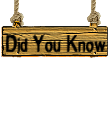The Power of The Power companies
More Stuff To Know
Do You Know What Tree That Is? | PDF
Do you know the types of trees you have? See if this helps you identify some of the most common trees in Tennessee and the southern states.
Fast Growing Trees | PDF
Looking for that perfect tree but dont want to wait forever having to worry about its small size? Although trees are slow growing plants in general, here are some of the faster growers.
Recognizing Hazardous Trees | PDF
Do you know how to spot a dangerous tree? This article will help you spot potential hazards before they happen.
Hiring A Tree Service | About.com
An article by David Beaulieu
A few things to consider when choosing and/or hiring a tree service for your trees.
When You Need An Arborist | About.com Another David Beaulieu article
What is the difference? How to know what type of service you need and where/what to look for.
Now Accepting All Forms of Payment
The scene,
You wake up in the morning, pour yourself a cup of coffee, and sip while looking out the window admiring your landscape. The rest of the morning goes as usual and you pull out of your driveway and head to work. That afternoon you are greeted by a horrible scene....someone has butchered what used to be a big, beautiful, healthy centeral focus of your landscape.
This is a story all too familiar to us. Time and time again we get calls from people saying the power company hired a crew to trim along the electric lines "uglifying" their trees and now they want a quote on getting them cleaned up. (or in some cases saved)
Many people dont know what their rights are concerning the city/county rights of way and the trees on their property, so below we have provided a little information and some links to check out.
MTEMC
Rights and Responsibilities
The Following Q&A was taken from this MTEMC webpage
WHY DOES MTEMC HAVE TO CUT TREES ALONG ITS PRIMARY RIGHT OF WAY 20 FEET ON BOTH SIDES?
When trees grow into or near power lines, they can cause power interruptions and safety concerns to you and your neighbors. MTEMC depends on a stringent trimming cycle to keep power lines free of tree growth. Trimming the entire power line on a regular basis instead of individual locations ensures an economical approach to maintaining the integrity of the power line. MTEMC’s sensible approach to trimming trees means having a thorough maintenance plan – a plan that improves the safety and reliability of electric service provided to you, our member.
Yes, if the tree is landscaped (mowed around) on a weekly basis, MTEMC will replace it with a five-foot-tall, low-growing species planted at an approved distance from the power line at no cost to the member. (See our list of replacement trees.)
CAN MEMBERS TRIM THEIR OWN TREES OR HIRE CONTRACTORS TO TRIM THEIR TREES INSTEAD OF ALLOWING MTEMC CONTRACTORS TO TRIM THEIR TREES?
No, Middle Tennessee Electric must first obtain the proper clearance required by OSHA in Ansi Z133.1. On secondary and service lines, MTEMC may choose to obtain clearance by first removing the line and then the member may trim the tree.
No, the chips are left on site and no dirt, seed, straw, etc., will be placed by MTEMC to the site.
Yes, MTEMC trims a five-foot radius around services (from the MTEMC power line to the home) during our regular six-year trimming cycle only. MTEMC does not trim services at any other time.
No, MTEMC trims trees to prevent electric outages on our system. Therefore, MTEMC wants to remove that tree before it causes an outage, not after. The tree still belongs to the member. In this case, our immediate priority is to restore power to our members.
Work planners go into the neighborhood to meet personally with members to discuss the work. These work planners are specially trained individuals, many of them certified arborists. They have flexible schedules to maximize their ability to meet with members. If a work planner is unable to contact a homeowner, a door hanger is left that explains the trimming that must be done. A telephone number is listed on the door hanger should the member have questions or concerns or call 1-877-414-7685.
Yes, MTEMC has the right and the obligation to its members to maintain any and all vegetation within its right of way. The court and legal system strongly support utilities’ right to trim and remove trees and or brush within and outside of the right of way.
Trimming should be done using the lateral pruning method, which was developed by the International Society of Arboriculture (ISA) and approved by the National Arborist Association, and the National Arbor Day Foundation. Lateral pruning leaves the overall structure of the tree stronger and more resistant to high winds and heavy ice. Future growth is directed away from power lines. Topping trees (also known as rounding over or shaping) is NOT endorsed by ISA because it leaves trees susceptible to disease and insect infestation.
Yes, if vegetation around un-energized structures such as poles, guys, span guys, etc., creates a safety or reliability risk, MTEMC may remove it.
TVA
Rights and Responsibilities
These questions are general in nature, designed to increase the landowners’ knowledge of their easements. TVA has purchased similar rights on most easements, following the general guidelines below. For specific questions, refer to the TVA transmission line easement grant on your property, or contact the TVA right of way specialist for your area.
WHAT ARE THE POLICIES FOR MAINTAINING TVA RIGHTS OF WAY
In 2003, the northeast area of the United States suffered a devastating failure of the electrical infrastructure supporting it. The After Action Review (AAR) of the event showed that although there were some mechanical equipment failures, the larger, more dangerous failures were from vegetation in the right of way. These vegetative failures are not 100 percent preventable, but to minimize their affects we use the guidelines specified below.
HOW WIDE ARE TVA’S TRANSMISSION LINE RIGHTS OF WAY?
Most TVA transmission line rights of way are 75 to 200 feet wide. Rights of way for multiple transmission lines are generally wider. In instances where a TVA transmission line is located near a property line, a portion of the width of the right of way may be on an adjacent property. Existing transmission lines are usually, but not always, located at the center of the right of way.
STANDARD RIGHT OF WAY WIDTHS
Of TVA’s 15,900 miles of transmission line, about 13,000 are 161-kilovolts (kV) or higher. Although right of way widths can vary, generally:
- 500-kV lines with two underbuilds commonly use a 200-foot right of way. (Underbuilds are transmission lines built under existing lines, using existing poles or structures as support.)
- 500-kV lines with a single underbuild commonly use a 175- to 200-foot right of way.
- 230-kV lines commonly use a 150-foot right of way.
- 161-kV single- or double-circuit lines commonly use a 150-foot right of way.
- 69-kV single-steel-pole lines commonly use a 75-foot right of way.
WILL MY DEED SHOW TVA EASEMENT?
The legal requirement for the sale of property requires a 35-year title search. TVA began purchasing easements in 1933. If you are about to purchase property near a transmission line, you should require a complete title search of at least 100 years. If a title search was not performed, you or your representative (surveyor or attorney) should search courthouse records. Contact the TVA right of way specialist for your area if the search does not reveal any records for the transmission line on your property.
CAN I PLANT AND GROW TREES ON THE TRANSMISSION LINE RIGHT OF WAY?
Typically easements were purchased to provide TVA perpetual rights to keep the right of way clear of trees so that it can build, protect, operate, maintain, and rebuild transmission lines. Therefore, most trees should not be grown within the right of way. With prior and express approval, TVA may allow low-growing vegetation that will not exceed 15 feet in height at some locations on the right of way, provided the vegetation does not exceed other TVA requirements for reliable operation of or access to the transmission line. Click here for a list of trees and shrubs that may be compatible with some areas of the transmission right of way.
DOES TVA HAVE ANY RESPONSIBILITY FOR KEEPING ITS RIGHTS OF WAY MOWED AND MAINTAINED?
Landowners are responsible for complying with city, county, and subdivision regulations regarding maintenance of their land, including that within a right of way. TVA has the perpetual right under most easement documents to clear rights of way and keep them clear of trees, brush, buildings, structures and fire hazards. These rights were acquired only to allow for the construction, operation, maintenance, and rebuilding of transmission lines.
DO I OWN TREES ON THE RIGHT OF WAY OR DOES TVA? DOES TVA PAY ME FOR THE TREES REMOVED ON MY RIGHT OF WAY?
TVA does not pay for trees removed from a right of way. When the right of way easement was purchased, the agreement included the trees in the right of way.
WILL TVA TRIM DANGER TREES LOCATED OUTSIDE THE RIGHT OF WAY RATHER THAN CUTTING THEM DOWN?
Tree-trimming is a hazardous and expensive activity. Generally, TVA removes danger trees instead of trimming them due to the expense and hazard of the maintenance. However, TVA is not required to reimburse property owners for any danger trees it removes.
IF TVA REMOVES A DANGER TREE THAT IS OFF THE EASEMENT, DO YOU HAVE THE RIGHT TO LEAVE THE FELLED TREE IN PLACE OR DO YOU HAVE TO MOVE IT ONTO THE EASEMENT?
TVA does not have a legal duty to move felled danger trees that are located outside a right of way onto the right of way after they are felled. TVA does not clean up trees in unmaintained wooded areas on or near the right of way. TVA has made it a practice, however, to clean up removed trees in residential areas, crop fields and pasture fields.
DOES TVA HAVE THE RIGHT TO REMOVE A TREE THAT IS LOCATED OUTSIDE A TRANSMISSION LINE RIGHT OF WAY?
Yes, if it is a “danger tree.” A danger tree is any tree located outside the right of way that would :
- come within five feet of an electric power line if it fell,
- would hit a transmission line structure if it fell, or
- would come within five feet of a transmission structure if it fell. (Some easement documents provide for a 10-foot distance.)
Almost all easement documents give TVA the right to remove such trees for the protection of the transmission line.
TVA also has the permanent right under most easement documents to remove any portion of a tree that is located off the right of way but extends over it, regardless of the height of the tree.
DO I NEED TO CONTACT TVA ABOUT TREES THAT ARE CLOSE TO OR WITHIN A TVA RIGHT OF WAY?
Yes, you should contact the TVA right of way specialist for your area about trees that are near or within a TVA right of way. Do not attempt to remove such trees yourself.









